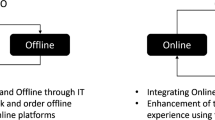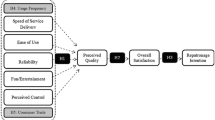Abstract
The development of self-service technologies (SSTs) has significantly changed the interactions between customers and enterprises. Similarly, traditional services are gradually being replaced. Self-service businesses are emerging one after the other, including self-service laundries, gas stations, car washes, ticketing machines, and even self-service stores. This is not merely a new trend, but a revolution in traditional consumption patterns and service models. Why do consumers continue to patronize self-service stores? Is the pushing force or the pulling force leading them to continue to switch from traditional shops to self-service stores? Or is this change the result of planned behavior or intention, determined by attitudes, subjective norms, and perceived behavioral control? This study integrates the theory of planned behavior and push-pull-mooring theory to determine the factors that influence consumers’ continuance intention toward self-service stores. Data was collected and analyzed, using structural equation modelling, from 231 consumers who accessed self-service car washes. Results showed that attitude was the most important factor affecting consumers’ continuance intention toward self-service stores. This was followed in order of relative importance by fun, habit, perceived behavioral control, and personal innovativeness. Subjective norms, low user satisfaction, perceived ease of use, and cost-savings did not affect consumers’ continuance intention toward self-service stores. Implications for theory and practice are being derived from these findings.
Access this chapter
Tax calculation will be finalised at checkout
Purchases are for personal use only
Similar content being viewed by others
References
Meuter, M.L., et al.: Self-service technologies: understanding customer satisfaction with technology-based service encounters. J. Market. 6(3), 50–64 (2000)
Dabholkar, P.A.: Consumer evaluations of new technology-based self-service options: an investigation of alternative models of service quality. Int. J. Res. Market. 13(1), 29–51 (1996)
Rosenbaum, M.S., Wong, I.A.: If you install it, will they use it? understanding why hospitality customers take “technological pauses” from self-service technology. J. Bus. Res. 68(9), 1862–1868 (2015)
Weijters, B., et al.: Determinants and outcomes of customers’ use of self-service technology in a retail setting. J. Serv. Res. 10(1), 3–21 (2007)
Globerson, S., Maggard, M.J.: A conceptual model of self-service. Int. J. Oper. Prod. Manag. 11(4), 33–43 (1991)
Ding, X., Verma, R., Iqbal, Z.: Self-service technology and online financial service choice. Int. J. Serv. Ind. Manag. 18(3), 246–268 (2007)
Rayport, J.F., Sviokla, J.J.: Exploiting the virtual value chain. Harv. Bus. Rev. 73(6), 75–85 (1995)
Lin, J.-S.C., Hsieh, P.-L.: The influence of technology readiness on satisfaction and behavioral intentions toward self-service technologies. Comput. Hum. Behav. 23(3), 1597–1615 (2007)
Curran, J.M., Meuter, M.L., Surprenant, C.F.: Intentions to use self-service technologies: a confluence of multiple attitudes. J. Serv. Res. 5(3), 209–224 (2003)
Dabholkar, P.A., Bagozzi, R.P.: An attitudinal model of technology-based self-service: moderating effects of consumer traits and situational factors. J. Acad. Mark. Sci. 30(3), 184–201 (2002)
Curran, J.M., Meuter, M.L.: Self-service technology adoption: comparing three technologies. J. Serv. Mark. 19(2), 109–113 (2005)
Liu, S.-F., Huang, L.-S., Chiou, Y.-H.: An integrated attitude model of self-service technologies: evidence from online stock trading systems brokers. Serv. Ind. J. 32(11), 1823–1835 (2012)
Elliott, K., Meng, G., Hall, M.: The influence of technology readiness on the evaluation of self-service technology attributes and resulting attitude toward technology usage. Serv. Mark. Q. 33(4), 311–329 (2012)
Liu, S.: The impact of forced use on customer adoption of self-service technologies. Comput. Hum. Behav. 28(4), 1194–1201 (2012)
Wang, C., Harris, J., Patterson, P.: The roles of habit, self-efficacy, and satisfaction in driving continued use of self-service technologies: a longitudinal study. J. Serv. Res. 16(3), 400–414 (2013)
Demoulin, N.T.M., Djelassi, S.: An integrated model of self-service technology (SST) usage in a retail context. Int. J. Retail. Distrib. Manag. 44(5), 540–559 (2016)
Elliott, K.M., Hall, M.C., Meng, J.G.: Consumers’ intention to use self-scanning technology: the role of technology readiness and perceptions toward self-service technology. Acad. Mark. Stud. J. 17(1), 129–143 (2013)
Gelderman, C.J., Ghijsen, P.W.T., Diemen, R.: Choosing self-service technologies or interpersonal services—the impact of situational factors and technology-related attitudes. J. Retail. Consum. Serv. 18(5), 414–421 (2011)
Bhattacherjee, A.: Understanding information systems continuance: an expectation-confirmation model. MIS Q. 25(3), 351–370 (2001)
Šavareikienė, D., Galinytė, R.: Self-Service as a Motivation to Choose Innovative Service. Socialiniai tyrimai/Soc. Res. 2(27), 19–28 (2012)
Ajzen, I.: From intentions to actions: a theory of planned behavior. In: Kuhl, J., Beckmann, J. (eds.) Action Control. SSSSP, pp. 11–39. Springer, Heidelberg (1985). https://doi.org/10.1007/978-3-642-69746-3_2
Ajzen, I.: The theory of planned behavior. Organ. Behav. Hum. Decis. Process. 50(2), 179–211 (1991)
Ajzen, I., Fishbein, M.: Belief, Attitude, Intention and Behavior: An Introduction to Theory and Research. Addison-Wesley, Reading (1975)
Taylor, S., Todd, P.A.: Understanding information technology usage: a test of competing models. Inf. Syst. Res. 6(2), 144–176 (1995)
Ravenstein, E.G.: The laws of migration. J. Stat. Soc. Lond. 48(2), 167–235 (1885)
Lee, E.S.: A theory of migration. Demography 3(1), 47–57 (1966)
Longino, C.F.: The Forest and the Trees: Micro-Level Considerations in the Study of Geographic Mobility in Old Age, in Elderly Migration and Population Redistribution, pp. 23–24. Belhaven Press, London (1992)
Nimako, S.G., Ntim, B.A.: Construct specification and misspecification within the application of push-pull-mooring theory of switching behaviour. J. Bus. Manag. Sci. 1(5), 83–95 (2013)
Moon, B.: Paradigms in migration research: exploring’moorings’ as a schema. Prog. Hum. Geogr. 19(4), 504–524 (1995)
Bansal, H.S., Taylor, S.F., James, Y.: “Migrating” to new service providers: Toward a unifying framework of consumers’ switching behaviors. J. Acad. Mark. Sci. 33(1), 96–115 (2005)
Langeard, E., et al.: Services Marketing: New Insights from Consumers and Managers. Marketing Science Institute, Cambridge (1981)
Keaveney, S.M., Parthasarathy, M.: Customer switching behavior in online services: an exploratory study of the role of selected attitudinal, behavioral, and demographic factors. J. Acad. Mark. Sci. 29(4), 374–390 (2001)
Dagger, T.S., David, M.E.: Uncovering the real effect of switching costs on the satisfaction-loyalty association: the critical role of involvement and relationship benefits. Eur. J. Mark. 46(3/4), 447–468 (2012)
Lam, S.Y., et al.: Customer value, satisfaction, loyalty, and switching costs: an illustration from a business-to-business service context. J. Acad. Mark. Sci. 32(3), 293–311 (2004)
Bansal, H.S., Taylor, S.F.: The service provider switching model (SPSM) a model of consumer switching behavior in the services industry. J. Serv. Res. 2(2), 200–218 (1999)
Jones, M.A., Mothersbaugh, D.L., Beatty, S.E.: Switching barriers and repurchase intentions in services. J. Retail. 76(2), 259–274 (2000)
Keaveney, S.M.: Customer switching behavior in service industries: an exploratory study. J. Mark. 59(2), 71–82 (1995)
Venkatesh, V., et al.: User acceptance of information technology: toward a unified view. MIS Q. 27(3), 425–478 (2003)
Wang, C.: Consumer acceptance of self-service technologies: an ability–willingness model. International Journal of Market Research 59(6), 787–802 (2017)
Xiaoren, Z., Xiangdong, C., Ling, D.: Comparative study of self-service technology adoption based on product function. Inf. Technol. J. 12(12), 2350–2357 (2013)
Howard, M., Worboys, C.: Self-service – a contradiction in terms or customer-led choice? J. Consum. Behav. 2(4), 382–392 (2003)
Agarwal, R., Prasad, J.: A conceptual and operational definition of personal innovativeness in the domain of information technology. Inf. Syst. Res. 9(2), 204–215 (1998)
Boyle, R.J., Ruppel, C.P.: The effects of personal innovativeness, perceived risk, and computer self-efficacy on online purchasing intent. J. Int. Technol. Inf. Manag. 15(2), 61–73 (2006)
Limayem, M., Hirt, S.G.: Force of habit and information systems usage: theory and initial validation. J. Assoc. Inf. Syst. 4, 65–97 (2003)
Limayem, M., Hirt, S.G., Cheung, C.M.K.: How habit limits the predictive power of intention: the case of information systems continuance. MIS Q. 31(4), 705–737 (2007)
Bamberg, S., Ajzen, I., Schmidt, P.: Choice of travel mode in the theory of planned behavior: the roles of past behavior, habit, and reasoned action. Basic Appl. Soc. Psychol. 25(3), 175–187 (2003)
Hair, J., et al.: Multivariate Data Analysis, 6th edn. Pearson Education, New Jersey (2006)
Nunnally, J.C.: Psychometric Theory. McGraw Hill, New York (1978)
Fornell, C., Larcker, D.F.: Evaluating structural equation models with unobservable variables and measurement error. J. Mark. Res. 18(1), 39–50 (1981)
Wang, Y.S.: Assessing ecommerce systems success: a respecification and validation of the DeLone and McLean model of IS success. Inf. Syst. J. 18(5), 529–557 (2008)
Ringle, C.M., Wende, S., Becker, J.M.: SmartPLS 3. SmartPLS GmbH, Boenningstedt (2015). http://www.smartpls.com
Chin, W.W.: The partial least squares approach for structural equation modeling. In: Marcoulides, G.A. (ed.) Modern Methods for Business Research. Lawrence Erlbaum Associates, Mahwah (1998)
Ganesh, J., Arnold, M.J., Reynolds, K.E.: Understanding the customer base of service providers: an examination of the differences between switchers and stayers. J. Mark. 64(3), 65–87 (2000)
Author information
Authors and Affiliations
Corresponding author
Editor information
Editors and Affiliations
Rights and permissions
Copyright information
© 2019 Springer Nature Switzerland AG
About this paper
Cite this paper
Chuang, SS., Lai, HM. (2019). Understanding Consumers’ Continuance Intention Toward Self-service Stores: An Integrated Model of the Theory of Planned Behavior and Push-Pull-Mooring Theory. In: Uden, L., Ting, IH., Corchado, J. (eds) Knowledge Management in Organizations. KMO 2019. Communications in Computer and Information Science, vol 1027. Springer, Cham. https://doi.org/10.1007/978-3-030-21451-7_13
Download citation
DOI: https://doi.org/10.1007/978-3-030-21451-7_13
Published:
Publisher Name: Springer, Cham
Print ISBN: 978-3-030-21450-0
Online ISBN: 978-3-030-21451-7
eBook Packages: Computer ScienceComputer Science (R0)




